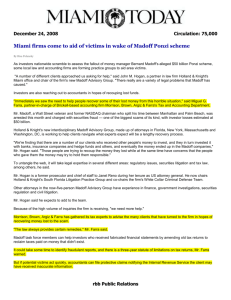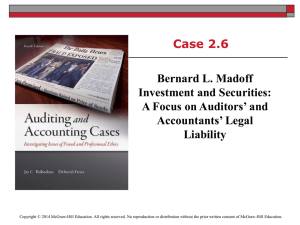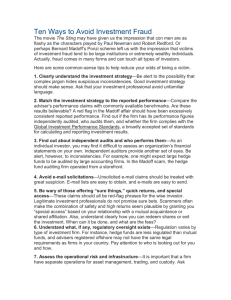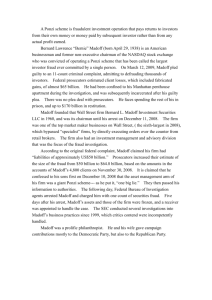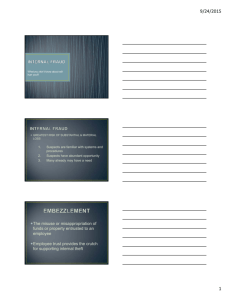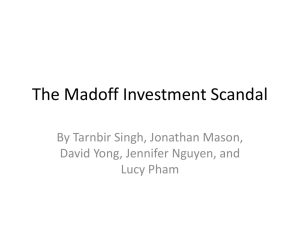Supreme Court’s Denial of Cert Preserves Safe Harbor for Madoff Victims
advertisement
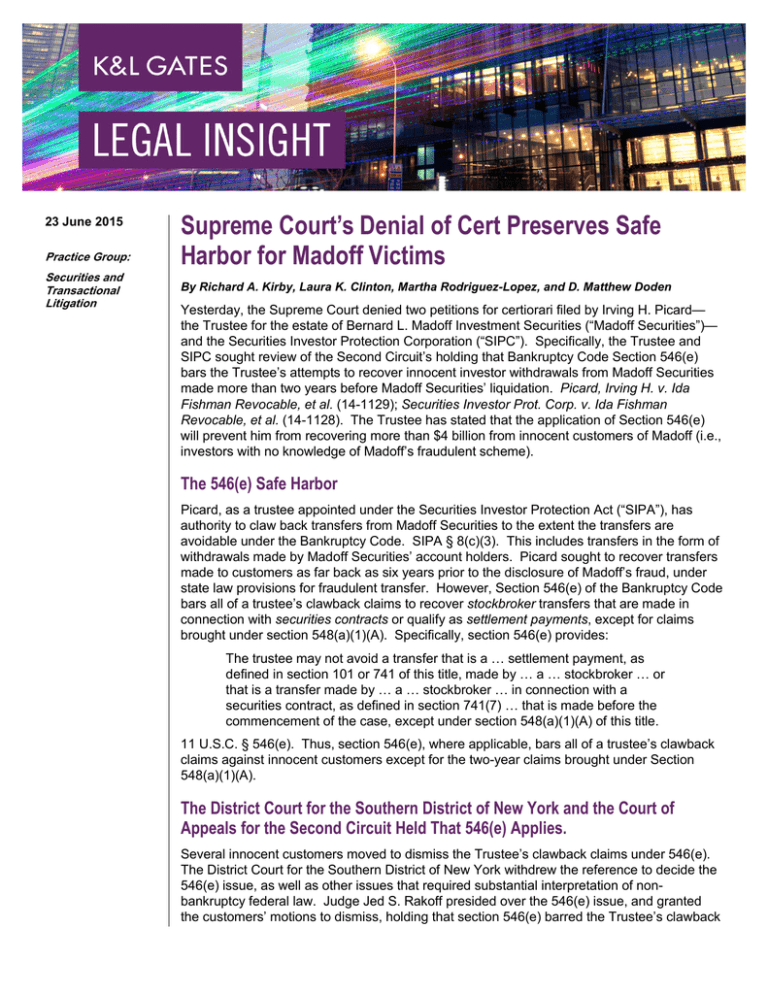
23 June 2015 Practice Group: Securities and Transactional Litigation Supreme Court’s Denial of Cert Preserves Safe Harbor for Madoff Victims By Richard A. Kirby, Laura K. Clinton, Martha Rodriguez-Lopez, and D. Matthew Doden Yesterday, the Supreme Court denied two petitions for certiorari filed by Irving H. Picard— the Trustee for the estate of Bernard L. Madoff Investment Securities (“Madoff Securities”)— and the Securities Investor Protection Corporation (“SIPC”). Specifically, the Trustee and SIPC sought review of the Second Circuit’s holding that Bankruptcy Code Section 546(e) bars the Trustee’s attempts to recover innocent investor withdrawals from Madoff Securities made more than two years before Madoff Securities’ liquidation. Picard, Irving H. v. Ida Fishman Revocable, et al. (14-1129); Securities Investor Prot. Corp. v. Ida Fishman Revocable, et al. (14-1128). The Trustee has stated that the application of Section 546(e) will prevent him from recovering more than $4 billion from innocent customers of Madoff (i.e., investors with no knowledge of Madoff’s fraudulent scheme). The 546(e) Safe Harbor Picard, as a trustee appointed under the Securities Investor Protection Act (“SIPA”), has authority to claw back transfers from Madoff Securities to the extent the transfers are avoidable under the Bankruptcy Code. SIPA § 8(c)(3). This includes transfers in the form of withdrawals made by Madoff Securities’ account holders. Picard sought to recover transfers made to customers as far back as six years prior to the disclosure of Madoff’s fraud, under state law provisions for fraudulent transfer. However, Section 546(e) of the Bankruptcy Code bars all of a trustee’s clawback claims to recover stockbroker transfers that are made in connection with securities contracts or qualify as settlement payments, except for claims brought under section 548(a)(1)(A). Specifically, section 546(e) provides: The trustee may not avoid a transfer that is a … settlement payment, as defined in section 101 or 741 of this title, made by … a … stockbroker … or that is a transfer made by … a … stockbroker … in connection with a securities contract, as defined in section 741(7) … that is made before the commencement of the case, except under section 548(a)(1)(A) of this title. 11 U.S.C. § 546(e). Thus, section 546(e), where applicable, bars all of a trustee’s clawback claims against innocent customers except for the two-year claims brought under Section 548(a)(1)(A). The District Court for the Southern District of New York and the Court of Appeals for the Second Circuit Held That 546(e) Applies. Several innocent customers moved to dismiss the Trustee’s clawback claims under 546(e). The District Court for the Southern District of New York withdrew the reference to decide the 546(e) issue, as well as other issues that required substantial interpretation of nonbankruptcy federal law. Judge Jed S. Rakoff presided over the 546(e) issue, and granted the customers’ motions to dismiss, holding that section 546(e) barred the Trustee’s clawback Supreme Court Denies Madoff Trustee’s Cert Petition on 546(e) Issue claims, except for the two-year claims brought under 548(a)(1)(A). Sec. Investor Prot. Corp. v. Bernard L. Madoff Inv. Sec. LLC, 476 B.R. 715, 722, 730 (S.D.N.Y. 2012). On review, the Second Circuit affirmed. In re Bernard L. Madoff Inv. Sec. LLC, 773 F.3d 411, 423 (2d Cir. 2014). As a threshold matter, the court acknowledged that “[s]ection 546(e) is a very broadly-worded safe-harbor provision that was enacted to ‘minimiz[e] the displacement caused in the commodities and securities markets in the event of a major bankruptcy affecting those industries.’” Id. at 416 (quoting Enron Creditors Recovery Corp. v. Alfa, S.A.B. de C.V., 651 F.3d 329, 334 (2d Cir. 2011)). Interpreting the plain language of 546(e) in light of that purpose, the court held that Madoff Securities was a stockbroker, and that his customers withdrew funds from their accounts in connection with their “securities contracts,” or, alternatively, that the customers’ withdrawals qualified as “settlement payments.” Id. at 417-23. Thus, the Second Circuit held that the section 546(e) safe harbor applied and barred all of Picard’s clawback claims against innocent customers, except for the two-year claims brought under section 548(a)(1)(A). Impact of the Supreme Court’s Denial of Certiorari Picard and SIPC petitioned the Supreme Court for review of the Second Circuit’s decision. Yesterday, the Supreme Court denied that petition. Picard has claimed that the application of 546(e) will reduce his potential recoveries by over $4 billion. For customers , the Supreme Court’s decision greatly reduces not only their potential liability, but also the scope of the remaining clawback litigation. Picard will only be able to proceed against customers under 548(a)(1)(A), and only for transfers occurring in the two years prior to the filing date of Madoff Securities’ liquidation (December 11, 2006–December 11, 2008). The Supreme Court’s denial of certiorari is a significant blow to Picard’s expansive view of a SIPA trustee’s clawback power. Authors: Richard A. Kirby richard.kirby@klgates.com +1.202.661.3730 Laura K. Clinton laura.clinton@klgates.com +1.206.370.7808 Martha Rodriguez Lopez martha.rodriguezlopez@klgates.com +1.206.370-7663 D. Matthew Doden matt.doden@klgates.com +1.206.370.7660 2 Supreme Court Denies Madoff Trustee’s Cert Petition on 546(e) Issue Anchorage Austin Beijing Berlin Boston Brisbane Brussels Charleston Charlotte Chicago Dallas Doha Dubai Fort Worth Frankfurt Harrisburg Hong Kong Houston London Los Angeles Melbourne Miami Milan Moscow Newark New York Orange County Palo Alto Paris Perth Pittsburgh Portland Raleigh Research Triangle Park San Francisco São Paulo Seattle Seoul Shanghai Singapore Spokane Sydney Taipei Tokyo Warsaw Washington, D.C. Wilmington K&L Gates comprises more than 2,000 lawyers globally who practice in fully integrated offices located on five continents. The firm represents leading multinational corporations, growth and middle-market companies, capital markets participants and entrepreneurs in every major industry group as well as public sector entities, educational institutions, philanthropic organizations and individuals. For more information about K&L Gates or its locations, practices and registrations, visit www.klgates.com. This publication is for informational purposes and does not contain or convey legal advice. The information herein should not be used or relied upon in regard to any particular facts or circumstances without first consulting a lawyer. © 2015 K&L Gates LLP. All Rights Reserved. 3
